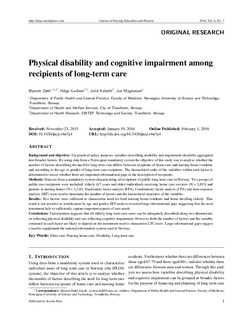| dc.contributor.author | Døhl, Øystein | |
| dc.contributor.author | Garåsen, Helge | |
| dc.contributor.author | Kalseth, Jorid | |
| dc.contributor.author | Magnussen, Jon | |
| dc.date.accessioned | 2016-05-19T12:15:30Z | |
| dc.date.accessioned | 2016-05-24T07:45:54Z | |
| dc.date.available | 2016-05-19T12:15:30Z | |
| dc.date.available | 2016-05-24T07:45:54Z | |
| dc.date.issued | 2016 | |
| dc.identifier.citation | Journal of Nursing Education and Practice 2016, 6(7) | nb_NO |
| dc.identifier.issn | 1925-4059 | |
| dc.identifier.uri | http://hdl.handle.net/11250/2390096 | |
| dc.description.abstract | Background and objective: For practical policy purposes variables describing disability and impairment should be aggregated into broader factors. By using data from a Norwegian mandatory system the objective of this study was to analyse whether the number of factors describing the need for long-term care differs between recipients of home care and nursing home residents and according to the age or gender of long-term care recipients. The hierarchical order of the variables within each factor is determined to assess whether there are important informational gaps in the description of recipients.
Methods: Data are from a mandatory system characterizing all recipients of public long term care in Norway. Two groups of public care recipients were included: elderly (67 years and older) individuals receiving home care services (N = 2,493) and patients in nursing homes (N = 1,218). Exploratory factor analysis (EFA), Confirmatory factor analysis (CFA) and item response analysis (IRT) were used to determine the number of factors and the hierarchical structures of the variables.
Results: Two factors were sufficient to characterise need for both nursing home residents and home dwelling elderly. This result is not sensitive to stratification by age and gender. IRT analysis revealed large informational gaps suggesting that the used instrument fails to sufficiently capture important aspects of user needs.
Conclusions: Factorization suggests that all elderly long term care users can be adequately described along two dimensions; on reflecting physical disability and one reflecting cognitive impairment. However, both the number of factors and the variable contained in each factor are likely to depend on the instrument used to characterise LTC users. Large informational gaps suggest a need to supplement the national information system used in Norway. | nb_NO |
| dc.language.iso | eng | nb_NO |
| dc.publisher | Sciedu Press | nb_NO |
| dc.rights.uri | http://creativecommons.org/licenses/by/3.0/ | |
| dc.title | Physical disability and cognitive impairment among recipients of long-term care | nb_NO |
| dc.type | Journal article | nb_NO |
| dc.type | Peer reviewed | nb_NO |
| dc.date.updated | 2016-05-19T12:15:30Z | |
| dc.source.volume | 6 | nb_NO |
| dc.source.journal | Journal of Nursing Education and Practice | nb_NO |
| dc.source.issue | 7 | nb_NO |
| dc.identifier.doi | 10.5430/jnep.v6n7p1 | |
| dc.identifier.cristin | 1335638 | |
| dc.description.localcode | This work is licensed under a Creative Commons Attribution 3.0 License. | nb_NO |

